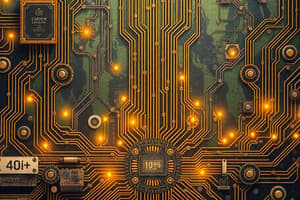Podcast
Questions and Answers
Which of the following characteristics is not a typical property of passive components?
Which of the following characteristics is not a typical property of passive components?
- They rely on the inherent properties of the materials they are made from
- They modify a signal without generating signals themselves
- They do not require any form of external power to operate
- They can amplify the power of a signal passing through them (correct)
Which of these components is primarily used for storing electrical energy in an electric field?
Which of these components is primarily used for storing electrical energy in an electric field?
- Capacitor (correct)
- Transformer
- Resistor
- Inductor
A resistor is used in a circuit to perform which of the following functions?
A resistor is used in a circuit to perform which of the following functions?
- Amplify current
- Oppose the flow of electric current (correct)
- Maintain a constant voltage level
- Store energy in a magnetic field
What key parameter is used to measure a capacitor's ability to store electrical energy?
What key parameter is used to measure a capacitor's ability to store electrical energy?
What is the primary function of an inductor in an electronic circuit?
What is the primary function of an inductor in an electronic circuit?
Which type of inductor is preferred when there is a need to minimize electromagnetic interference?
Which type of inductor is preferred when there is a need to minimize electromagnetic interference?
What is the main purpose of a transformer in an electrical circuit?
What is the main purpose of a transformer in an electrical circuit?
What parameter of a transformer determines the voltage transformation ratio between its primary and secondary windings?
What parameter of a transformer determines the voltage transformation ratio between its primary and secondary windings?
What is the primary function of a diode in an electronic circuit?
What is the primary function of a diode in an electronic circuit?
In what application are Zener diodes commonly used?
In what application are Zener diodes commonly used?
What is the main function of a fuse in an electrical circuit?
What is the main function of a fuse in an electrical circuit?
Which parameter of a fuse indicates the maximum current it can handle before interrupting the circuit?
Which parameter of a fuse indicates the maximum current it can handle before interrupting the circuit?
What is the purpose of a potentiometer in a circuit?
What is the purpose of a potentiometer in a circuit?
In what application would a potentiometer be commonly used?
In what application would a potentiometer be commonly used?
What is the defining characteristic of a thermistor?
What is the defining characteristic of a thermistor?
What is the function of a varistor in an electrical circuit?
What is the function of a varistor in an electrical circuit?
What is the primary application of a crystal oscillator?
What is the primary application of a crystal oscillator?
Which of the following is a key characteristic of active components?
Which of the following is a key characteristic of active components?
Which of the following components is an example of an active component?
Which of the following components is an example of an active component?
What is a key difference between active and passive components in electronic circuits?
What is a key difference between active and passive components in electronic circuits?
Flashcards
Passive Components
Passive Components
Electronic components that don't need external power to operate. They modify signals without generating them.
Capacitors
Capacitors
They store electrical energy in an electric field.
Inductors
Inductors
They store electrical energy in a magnetic field.
Diodes
Diodes
Signup and view all the flashcards
Transformers
Transformers
Signup and view all the flashcards
Crystals
Crystals
Signup and view all the flashcards
Resistor
Resistor
Signup and view all the flashcards
Capacitor
Capacitor
Signup and view all the flashcards
Inductor
Inductor
Signup and view all the flashcards
Transformer
Transformer
Signup and view all the flashcards
Diode
Diode
Signup and view all the flashcards
Fuse
Fuse
Signup and view all the flashcards
Potentiometer
Potentiometer
Signup and view all the flashcards
Thermistor
Thermistor
Signup and view all the flashcards
Varistor
Varistor
Signup and view all the flashcards
Crystal Oscillator
Crystal Oscillator
Signup and view all the flashcards
Active Components
Active Components
Signup and view all the flashcards
Transistors
Transistors
Signup and view all the flashcards
Integrated Circuits
Integrated Circuits
Signup and view all the flashcards
Light Emitting Diodes
Light Emitting Diodes
Signup and view all the flashcards
Study Notes
- Electronics circuit devices and analysis
- Prepared by Prof Keith Hezekiah H. Presno
Passive Components
- Passive components do not need external power to operate
- Passive components cannot amplify or increase signal power
- Passive components modify but do not generate signals
- They operate based on the material's properties
- Primarily attenuate or modify the signal passing through them
- Ideally, behave linearly where output is proportional to input
- Passive components are fundamental building blocks in electronics circuits
Examples of Passive Components
- Capacitors store electrical energy in an electric field
- Inductors store electrical energy in a magnetic field
- Basic diodes primarily control the direction of current flow, some exhibit active behavior
- Transformers transfer electrical energy through electromagnetic induction
- Crystals are used for precise timing in oscillators
Resistor
- Opposes electric current flow, controlling the amount of current in a circuit
- Dissipates energy in the form of heat
- Resistance is measured in ohms (Ω)
- Power rating is measured in watts (W)
- Applications include current limiting, voltage division, plus pull-up/pull-down in digital circuits
Capacitor
- Stores electrical energy in an electric field
- It comprises two conductive plates separated by a dielectric
- Capacitance is measured in farads (F)
- Voltage rating is the maximum voltage it can handle
- Ceramic capacitors feature small but stable capacitance
- Electrolytic capacitors feature high capacitance and are polarized
- Film capacitors feature high precision and are non-polarized
- Used for filtering, e.g., smoothing power supply ripple
- Used for coupling and decoupling signals
- Used for energy storage, e.g., in flash circuits
Inductor
- Stores energy in a magnetic field when current flows, opposing changes in current
- Inductance is measured in Henries (H)
- Current rating is the maximum current that it can handle
- Air-core inductors feature low inductance with no core loss
- Iron-core inductors are compact with minimum electromagnetic interference
- Used for filtering, e.g., in LC filters
- Used for energy storage, e.g., in switch-mode power supplies
- Used for impedance matching
Transformer
- Transfers electrical energy between two or more circuits via electromagnetic induction
- Primary and secondary windings are wrapped around a core
- Turns ratio determines voltage transformation
- Power rating signifies its max power handling
- Step-up transformers increase voltage
- Step-down transformers decrease voltage
- Isolation transformers provide electrical isolation
- Applications include voltage step-up/down in power supplies
- Applications impedance matching in audio systems
- Applications isolation in safety-critical circuits
Diode
- Passive in certain contexts, allowing current flow in one direction
- Functions as a one-way valve for electric current
- Forward voltage drop is typically 0.7V for silicon diodes
- Reverse breakdown voltage is the other key parameter
- Rectifier diodes are used in power supplies
- Zener diodes are used for voltage regulation
- Light-emitting diodes (LEDs) emit light when forward-biased
- Used for rectification (converting AC to DC)
- Used for voltage regulation with Zener diodes
- Used for signal demodulation
Fuse
- Acts as a safety device that protects circuits from overcurrent
- Breaks the circuit when current exceeds a specified value
- Current rating is the maximum current it can handle
- Breaking capacity is the maximum current it can interrupt
- Fast-acting fuses quickly respond to overcurrent
- Slow-blow fuses tolerate temporary surges
- Applications include overcurrent protection in power supplies
- Applications circuit protection in automotive and industrial systems
Potentiometer
- Potentiometers are also called variable resistors
- Works as a three-terminal resistor with adjustable sliding contact to work as a voltage divider
- Resistance range (e.g., 0 - 10 kΩ) plus taper (linear or logarithmic) matters
- Used for volume control in audio systems
- Used for brightness control in displays
- Used for calibration and tuning in circuits
Thermistor
- A thermistor is a temperature-sensitive resistor
- Resistance changes with temperature
- Measured for resistance at a reference temperature (e.g., 25°C)
- Measured for temperature coefficient (positive or negative)
- NTC (Negative Temperature Coefficient) sees resistance decrease with temperature
- PTC (Positive Temperature Coefficient) sees resistance increase with temperature
- Used for temperature sensing and control
- Used for overcurrent protection with PTC thermistors
- Used for compensation in circuits
Varistor
- Varistors are also called voltage-dependent resistors
- Protects circuits from surges/voltage spikes
- Changes resistance with applied voltage
- Clamping voltage is the voltage at which it starts conducting
- Energy absorption capacity is also key
- Used for surge protection in power supplies
- Used for protection against lightning strikes
Crystal Oscillator
- It uses the mechanical resonance of a vibrating crystal
- Generates a precise electrical signal with a specific frequency
- Frequency (e.g., 4 MHz, 16 MHz) matters
- Stability (e.g., ±10 ppm) matters
- Used for clock generation in microcontrollers and digital circuits
- Used for frequency control in communication systems
Active Components
- Active components need an external power source
- Can amplify signals
- Offer signal control
- Convert energy
- Building blocks for "intelligence" and circuit functionality
- They can amplify signals, switch signals, or perform logic operations
- Behavior is often non-linear
- Output signal is not simply proportional to the input signal
- Used for complex circuits with advanced capabilities
Examples of Active Components
- Transistors (BJTs, FETs) amplify current or voltage as switches.
- Diodes exhibit active characteristics, e.g., Zener, varactor, tunnel diodes
- Integrated Circuits (containing transistors, resistors, etc. on a chip)
- Operational Amplifiers (Op-Amps) amplify analog signals
- Microprocessors (MPUs) are general-purpose processors in computers and embedded systems
- Microcontrollers (MCUs) are self-contained systems-on-a-chip with a processor, memory, etc.
- Logic Gates perform basic logic operations
- Memory Chips (RAM, ROM) store digital data
- Vacuum Tubes amplify signals
- Thyristors (SCRs, Triacs) control AC power.
- Light Emitting Diodes (LEDs) convert electrical energy into light.
Studying That Suits You
Use AI to generate personalized quizzes and flashcards to suit your learning preferences.




